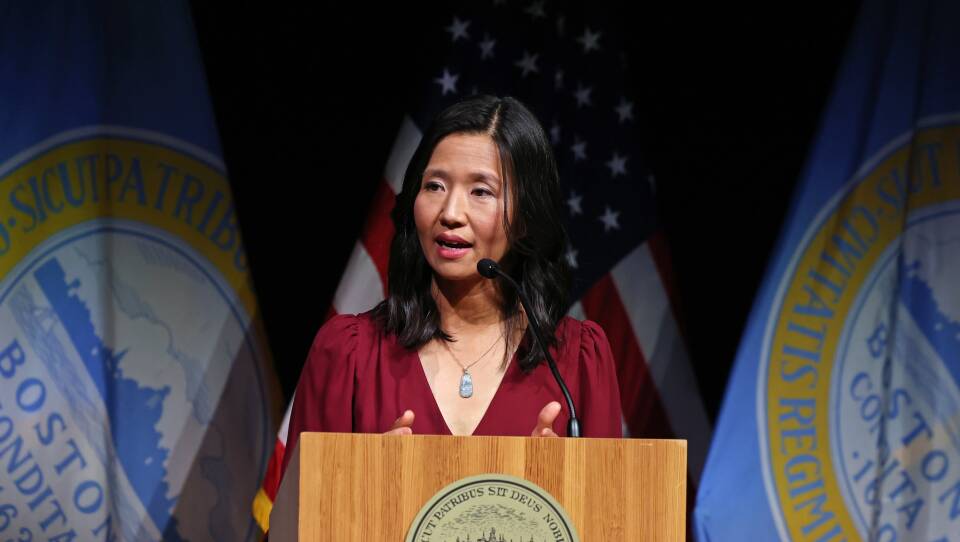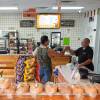Boston Mayor Michelle Wu acknowledged recent progress in Boston Public Schools while pushing for further investments during the city’s first “State of the Schools” address on Tuesday night.
The mayor announced several ambitious goals, including increasing access to before- and after-school programming, and having all BPS students learning at grade level by the end of next year.
The larger objective, Wu said, was to transform BPS into a top performing district.
“We are the oldest public school system in the nation,” she said. “And together, it’s time that we make it the best.”
Her speech comes as the district faces ongoing challenges, including chronic absenteeism, low test scores, and a facilities plan for closures and mergers that would shutter 17 schools by 2030.
Still, Wu said the district has made progress under Superintendent Mary Skipper’s leadership.
“After being stuck in the bottom 10% of schools in the state for more than a decade, BPS has leapfrogged 28 other school districts in the last three years,” Wu said in her remarks. “After years of instability, we’re seeing real, meaningful progress. But we’re not yet where we need to be.”
The address was announced just weeks after the release of the 2025 MCAS results, which showed that the district’s students continue to lag far behind pre-pandemic scores on the state test.
Wu said the solution was to push students who are struggling instead of lowering expectations.
“When we shelter students from challenge, we stunt growth. When we expect less, they deliver less,” she said. “So yes, students will be supported, they will have fun, they will be part of a community, and they will also be challenged.”
The mayor also pledged more district support for student achievement, including a citywide goal to provide before- and after-school programming at every BPS school.
“Right now, 17% of our schools have before- and after-school programs,” Wu said. “At the 83% of schools that do have them, many families still can’t afford or access these critical supports because programs don’t accept state vouchers or have enough spots.”
The district is starting with 20 new programs at 20 community hub schools and families will be able to use state vouchers at their child’s school.
Boston Teachers Union President Erik Berg said he was heartened by to hear about this initiative.
“We think that community schools are one of the ways that our schools can better meet the needs of our students and their families and make our city a better place for everyone,” Berg said.
Boston Policy Institute Executive Director Gregory Maynard said expanding before- and after-school programming is valuable, but it’s unclear how it would improve student achievement.
“How is that going to improve test scores at the bottom 10% of schools where 40% of BPS students attend?” Maynard said. “I think you have to make those implications.”
With a school budget that already surpasses $1.5 billion, Wu did not offer specifics on how the city would pay for the new initiatives. And she acknowledged that Boston has been a target in the “federal political storm” through the loss of grants and funding cuts.
“While the Trump administration tries to dismantle public education by neglect and by force, we are doubling down on setting the highest standards for student achievement by getting the operational details,” Wu said.
Maynard said overall, he doesn’t think Wu’s speech included a specific plan to help the district improve.
“Letting kids into art museums is cool, but BPS can’t get kids to school on time. BPS is doing a poor job of educating them. BPS’s buildings are falling apart,” he said. “It seems like some of those issues should be addressed with some big plan in this big new speech that she held.”
Maynard added that Wu failed to acknowledge the large number of Boston students who are below grade level in math and reading or a plan to help these students improve.
Berg said he’s happy to see Wu putting students and schools front and center.
Berg added that the city and BPS have opened three new school buildings in the past three years, and significantly renovated three others.
”We hope that the city and the state continues to invest in the needs of our school facilities because it’s important for all of our students to be able to learn in learning environments that are built for the 21st century and not the 19th century,“ Berg said.





